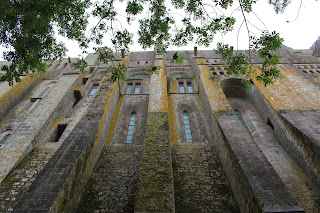 |
| Mont Saint Michel |
 |
| Mytili grown on a bouchot |
Moules bouchots are mussels grown on wooden piles (bouchots) that are driven into the seabed. The upper part of the bouchot is wound about with rope and netting that's seeded with mussel gametes that will develop into full grown mussels. The developing mussels are underwater at high tide, but exposed to air and sun when the tide recedes, giving them a distinctive flavor. The orange-fleshed moules bouchots grown in the Bay of Mont Saint Michel in Normandy are prized for their superior flavor and are the most sought after moules in France.
 |
| Monsieur Moule and me |
 |
| Everything you need to know about mytili, illustrated |
The Musée de la Mytiliculture had a large upstairs space devoted to the life cycle of mytili (mussels), and the bouchot farming method. There was a smiling moule statue on the stair landing, beckoning visitors to the exhibition above. A series of amusing illustrations captioned in French and English did a good job of explaining how mussels are grown and harvested using the bouchot method.
There were lot of photos of the process, and a bouchot with netted mussels wound around it. Some of us posed with a curious figure made of driftwood and netting that was decorated with seaweed and shells. This museum had a lot of "extras" that made it particularly delightful…
…including the signs that directed visitors to the restrooms:
One evening we sampled some of these delicious moules bouchots at a great restaurant in Cancale, a picturesque fishing village on the Bay of Mont Saint Michel.
 |
| Moules at restaurant A Contre Courant (Against the Current) in Cancale |
MONT SAINT MICHEL
Mont Saint Michel's distinctive form is visible for many miles around. It's a walled fortress town, built on a rocky tidal island. A solid causeway road connecting the island with the mainland was built in 1879, disrupting the flow of seawater around the Mont. Since then the part of the bay surrounding the island has silted up, leaving sand flats instead of water. To prevent further silt buildup the solid causeway is being replaced by a curving bridge. A new hydraulic dam built near the mouth of the nearby River Couesnon captures river and tide water and releases it in great flushing actions that are working to release the Mont from the silt and mud. Thanks to these improvements, it's expected that within ten years Mont Saint Michel will again be surrounded by water at high tide.
 |
| Le Grand Rue, Mont Saint Michel |
The Mont has attracted religious pilgrims since the 6th century, when hermit monks settled on the island. Today the "pilgrims" are tourists who come from all over the world to visit this remarkable place. The tourist-pilgrims jam the lower part of Le Grand Rue, a funny name for the narrow, souvenir shop infested pedestrian street that winds its way up the center of the island. The crowds thin out as you climb higher and higher up the series of steps that take you to the Abbey church that crowns Mont Saint Michel.
 |
| View of the surrounding sand flats from the Abbey ramparts |
Construction of the present romanesque Abbey was started in 1023. The long steep climb up stone steps to visit the Abbey is worth the effort! Views from the upper ramparts are heavenly. It's easy to see why Benedictine monks and pilgrims felt closer to God in this beautiful place.
 |
| Abbey cloister garden |
 |
| The scriptorium |
The middle level held guest chambers for visiting nobility, and a scriptorium where monks would copy and illuminate religious texts by hand in pre-printing press days. The scriptorium is a beautiful space with lots of windows and multiple fireplaces. The vaulted ceiling's supporting columns are decorated with floral motifs carved from stone. I thought this was the most beautiful room in the Abbey.
Off a hallway in one of the lower levels of the Abbey we saw a giant "human hamster wheel" made of wood. It had been used to power a winch that hauled supplies up the wall of the fortress on a giant sledge. From 1793 to 1863 Mont Saint Michel was used as a prison (the French revolution started the trend, imprisoning "political offenders" in the Abbey). During the Abbey's time as a prison, teams of 6 prisoners labored two abreast to power the wheel.
 |
| North wall of the 3-storey Merveille |
At the end of the tour we exited via an exterior staircase that took us to a grassy terrace at the base of the 3-storey Abbey. Looking up I could pick out the windows for each of the levels that we'd explored. The ancient building has been called La Merveille (the Marvel) by generations of pilgrims. Count me as one more pilgrim who has marveled at this architectural wonder that's perched on top of Normandy's island of Mont Saint Michel.




Free Slots Online - No Download, No Registration
ReplyDeleteYou may play online slots from 온카판 the comfort 도박사이트 of your own home by following the links below. No 마추 자 먹튀 registration needed. Play 스포츠 벳 for free 에이스포커 and real money!